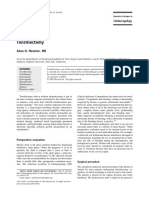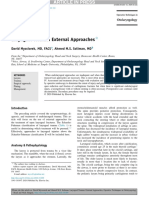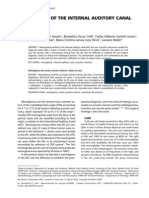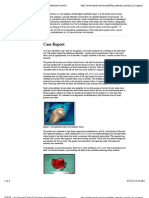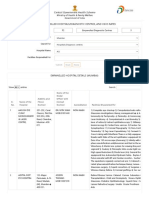0 ratings0% found this document useful (0 votes)
32 viewsGhan em 2005
Ghan em 2005
Uploaded by
asfwegereghanem 20015
Copyright:
© All Rights Reserved
Available Formats
Download as PDF, TXT or read online from Scribd
Ghan em 2005
Ghan em 2005
Uploaded by
asfwegere0 ratings0% found this document useful (0 votes)
32 views5 pagesghanem 20015
Original Title
Ghan Em 2005
Copyright
© © All Rights Reserved
Available Formats
PDF, TXT or read online from Scribd
Share this document
Did you find this document useful?
Is this content inappropriate?
ghanem 20015
Copyright:
© All Rights Reserved
Available Formats
Download as PDF, TXT or read online from Scribd
Download as pdf or txt
0 ratings0% found this document useful (0 votes)
32 views5 pagesGhan em 2005
Ghan em 2005
Uploaded by
asfwegereghanem 20015
Copyright:
© All Rights Reserved
Available Formats
Download as PDF, TXT or read online from Scribd
Download as pdf or txt
You are on page 1of 5
The Laryngoscope
Lippincott Williams & Wilkins, Inc.
© 2005 The American Laryngological,
Rhinological and Otological Society, Inc.
Rethinking Auricular Trauma
Tamer Ghanem, MD, PhD; J. K. Rasamny, BA; Stephen S. Park, MD
Objectives/Hypothesis: An unrecognized auricu- INTRODUCTION
lar hematoma can lead to a disfiguring deformity, the An auricular hematoma occurs because of blunt
cauliflower ear, but it can be prevented with prompt trauma to the auricle.1,2 Unrecognized or improperly
and comprehensive management. Fine needle aspira- treated, it can result in the conspicuous cauliflower ear
tion with pressure bandages remains the mainstay deformity, which has been recognized since the ancient
treatment but will occasionally fail. We review our Greek wrestlers. In fact, the deformity remains a common
experience with recurrent or recalcitrant auricular stigmata to wrestlers, boxers, and rugby players. The un-
hematomas in terms of their pathophysiology and re-
managed auricular hematoma can lead to infection, carti-
vision surgery. Study Design: Retrospective chart re-
lage necrosis, contracture, and neocartilage formation.
view. Methods: A review of patients undergoing sur-
gical incision, drainage, and debridement secondary There are a variety of treatments aimed at preventing
to recurrent auricular hematomas was conducted. these complications and returning the auricle to its pre-
Demographic data was collected, intraoperative trauma form.3–11 Typically, a graduated approach is un-
notes were reviewed, and follow-up results were ob- dertaken depending on the extent of the injury and the
tained. Our management included an open incision, time from initial insult. For small hematomas that are
aggressive debridement, and long term bolsters to the discovered acutely, a needle aspiration with a bolster
ear. Results: Ten patients presented with a persistent dressing is recommended. For a few days postinjury, the
auricular hematoma and deformity following outpa- hematoma will become a coagulated clot, and needle aspi-
tient management with either incision and drainage ration is often ineffective. After roughly a week, the clot
or fine needle aspiration. All were male with a mean usually breaks down, and aspiration is once again possi-
age of 25 years, presenting for surgery on average 19 ble. Larger hematomas may warrant an open approach or
days following initial trauma. The location of the he- placement of a drain. Postoperative antibiotic prophylaxis
matoma within this group was not limited to the po- against skin flora is generally recommended. Despite
tential space between the cartilage and perichon- these measures, treatment of auricular hematomas can be
drium. The hematoma was clearly located within the
frustrating because of their common recurrence, which
cartilage itself and it is postulated that this is one of
can occur several days postevacuation.
the primary reasons for initial failure. Following sur-
gical incision and drainage there were no recur- Complete extirpation of auricular hematomas is
rences or complications. Conclusion: There is a select therefore key to adequate treatment. To completely evac-
group of patients with refractory auricular hemato- uate the auricular hematoma, it is important for the sur-
mas that require more aggressive treatment over a geon to have a proper understanding of the pathophysiol-
fine needle aspiration. Open debridement is indicated ogy of auricular hematoma. Blunt trauma causes shearing
for this group. The location of the hematoma, granu- forces between the anterior auricular skin, perichon-
lation tissue, and neo-cartilage is found to be within drium, and cartilage. Classically, the hematoma is
the cartilage itself rather than between the cartilage thought to form in the potential space between the peri-
and perichondrium, thus explaining why a needle as- chondrium and ear cartilage.1 Careful studies investigat-
piration alone can be ineffective. Key Words: Auricu- ing the etiology of this deformity suggest that the hema-
lar trauma, auricular hematoma, surgical manage- toma actually occurs intracartilaginously (i.e., in the ear
ment, cauliflower ear. cartilage itself).2 The basis for these studies will be ex-
Laryngoscope, 115:1251–1255, 2005 plored further in the Discussion section. Once the hema-
toma forms, it will organize with fibroblast infiltration
and eventual neocartilage formation. One reason for re-
From the Department of Otolaryngology—Head and Neck Surgery, currence or for progression to the cauliflower deformity is
University of Virginia, Charlottesville, Virginia, U.S.A.
incomplete removal of the hematoma, which is expected to
Editor’s Note: This Manuscript was accepted for publication March
15, 2005. occur with multiloculated hematomas arising within the
Send Correspondence to Dr. Stephen S. Park, Department of Oto- cartilage proper.
laryngology—Head and Neck Surgery, PO Box 800713, University of Vir- The purpose of this paper is to review our experience
ginia, Charlottesville, VA 22908, U.S.A.
with the management of recurrent auricular hematomas
DOI: 10.1097/01.MLG.0000165377.92622.EF and to explore their pathophysiology. The study subjects
Laryngoscope 115: July 2005 Ghanem et al.: Rethinking Auricular Trauma
1251
were limited to patients with recurrent or persistent he- The other four hematomas were firm to palpation and
matomas of the ear. were not felt to be amenable to needle aspiration. Those
patients went directly to surgical incision and drainage,
MATERIALS AND METHODS without attempts at needle aspiration. Hematomas oc-
A retrospective chart review was conducted for patients curred along the superior half of the ear, involving the
with auricular hematomas treated at a tertiary care hospital scaphoid fossa, triangular fossa, antihelix, concha cymba,
between December 2001 and May 2004. Prior approval was ob-
and concha cavum. The location of the hematoma was
tained from the human investigation committee. All patients
determined through the operative note and found to be
included in this study underwent surgical incision and drainage
of their auricular hematoma. Demographic data, previous proce- intracartilagenous (i.e., sheets of native cartilage could be
dures, intraoperative findings, follow-up results, and complica- found on both the anterior and posterior borders of the
tions were recorded. hematoma). The lesions consisted of clot, serum, fibrous
An anterior incision was made along the inner aspect of the tissue, and fragments of normal cartilage. There were no
helix or antihelix, depending on the epicenter of the hematoma. A complications or recurrences on follow-up of at least 1
skin flap was elevated over the underlying hematoma with care month. All patients were specifically instructed to return
taken to identify the precise location of the lesion with respect to if there were any signs of erythema, tenderness, or recur-
the perichondrium and cartilage. All blood, granulation tissue,
rent swelling.
necrotic cartilage, and fibrous tissues were completely evacuated.
The skin was closed with absorbing suture and a through-and-
through bolster dressing applied for 1 week. Perioperative sys-
temic antibiotics were prescribed for 7 days. Case Presentation
A sixteen-year-old male wrestler presented 2 weeks
RESULTS after suffering a right auricular hematoma in a wrestling
Ten patients with recurrent auricular hematomas match. He had two previous unsuccessful fine needle as-
were identified from February 2001 to March 2004 and piration procedures with a dental roll bolster dressing by
included in this study. All were male with a mean age of an outside otolaryngologist. His preoperative photographs
25 (14 – 49) years. Causation in descending frequency were are shown in Figure 1. He was taken to the operating room
wrestling (n ⫽ 4), fighting (n ⫽ 3), self-inflicted (n ⫽ 1), on posttrauma day 22 for incision and drainage. The inci-
and unknown (n ⫽ 2). The time interval from trauma to sion was made along the inside surface of the helix, and
the surgical intervention ranged from 2 to 38 (mean 19) the skin was elevated off the lesion (Fig. 2). The hema-
days. Five patients underwent previous unsuccessful nee- toma was located within the cartilage, as shown in Figure
dle aspirations: three patients underwent one previous 3. The hematoma and excess cartilage were debrided, the
unsuccessful needle aspiration, and two patients had two wound irrigated and closed, and a transauricular pressure
previous unsuccessful needle aspirations. One patient had bandage applied (Fig. 4). On 10-month follow-up, he had
two unsuccessful attempts at open incision and drainage. no evidence of hematoma recurrence (Fig. 5).
Fig. 1. (A) Side view of 16 year old
patient with a 2-week-old auricular
hematoma. (B) Front view.
Laryngoscope 115: July 2005 Ghanem et al.: Rethinking Auricular Trauma
1252
Fig. 2. (A) Incision site along the
inner aspect of the helix. (B) View
after elevation of the anterior auricu-
lar skin, showing deformed ear carti-
lage.
DISCUSSION studying auricular hematoma pathophysiology than in-
There is controversy in the literature as to the precise jecting blood clots in rabbit ears.
location of the traumatic auricular hematoma, but classic The current study addresses recurrent hematomas
teaching is that they occur between the perichondrium and does not reflect the typical patient with blunt auric-
and cartilage. This dogma is derived from a study by ular trauma; a majority are probably successfully man-
Ohlsen et al.1 in which they surgically injected blood clots aged with needle aspiration and short-term bolsters. Even
in different locations in the rabbit ear. When the blood clot larger fluctuant hematomas can be aspirated. The location
was placed between the skin and perichondrium, the blood of these common hematomas may indeed be between the
clot resorbed in 21 days. However, if the blood clot was cartilage and perichondrium. Within our recurrent/persis-
placed between the perichondrium and cartilage, new car- tent patient group, however, the location of the auricular
tilage formed within the subperichondrial plane over a hematoma was clearly described and discovered to be
4-week interval. The possibility of a hematoma originally within the cartilage proper. Operative dissection not only
forming within the ear cartilage itself was not specifically confirmed this location but also the presence of fibrous
tested in this study. This study is widely cited and is the tissue and neocartilage. This multiloculated geometry
basis for our current understanding of the pathophysiol- would predispose to failure after a single puncture and
ogy of auricular hematomas. aspiration. For this subgroup of patients, an aggressive
Two years before the above study, another experi- extirpation of the hematoma with debridement is required
ment was performed to address the same question. A to prevent recurrence. The current results are similar to
rabbit animal model was used to simulate auricular those reported elsewhere; however, the exact location
hematomas by dropping a 10 g weight from a fixed within the cartilage was not discussed.4,6,11 An aggressive
height on the lateral aspect of the pinna.2 The cartilage extirpation was the treatment of choice.
was evaluated at various time points by histologic sec- Long-term follow-up can be a challenge because
tioning and light microscopy. Hematoma formation was many patients were referred by otolaryngologists from a
more likely if the force was tangential, producing a distance. Each patient was specifically instructed to call or
shearing force between skin and cartilage. The hemato- return for any signs of recurrence, and none did. Hema-
mas were mostly found to be intracartilaginous and tomas would certainly recur within a month but the fibro-
associated with a tear through the cartilage. The hema- sis and contracture could be a later sequelae and more
toma was replaced by fibrous tissue, with the fibroblast difficult to tract. The patient in the case presentation was
slowly producing immature neocartilage. The combina- followed for 10 months, and he was free of recurrence and
tion of fibrosis, contracture, and neocartilage was contracture.
thought to be the pathogenesis of the cauliflower ear Auricular hematomas can be divided in two catego-
deformity seen clinically. This study, although less cited ries to help in therapy. Fluctuant hematomas that are
in the literature, takes a more physiologic approach to discovered acutely can usually be managed with needle
Laryngoscope 115: July 2005 Ghanem et al.: Rethinking Auricular Trauma
1253
Fig. 3. (A) The deformed ear cartilage
is opened and fibrous tissue and he-
matoma is seen. (B) The fibrous tis-
sue and hematoma is extirpated, ex-
cess native ear cartilage is held
between the forceps, demonstrating
the location of the hematoma.
aspiration. The second group represents those older he- CONCLUSIONS
matomas that tend to be more fibrotic in nature or those Auricular hematomas arise from blunt trauma to the
that are recurrent after needle aspiration, which often auricle. Shearing forces between the anterior auricular
require an open evacuation. Hematomas located within skin and underlying cartilage are believed to be responsi-
the cartilage itself may be predisposed to recurrence and ble for the hematoma. The location of the hematoma has
warrant the more aggressive initial treatment. been classically described as between the perichondrium
and cartilage; however, in some patient groups, the hema-
tomas can arise within the cartilage itself. These findings
are clinically useful as guidelines in the management of
auricular hematomas. First, complete evacuation of the
hematoma and fibrous tissue needs to be performed
through adequate access. All abnormal neocartilage and
fibrous tissues should be aggressively debrided.
Fig. 5. Ten-month follow-up side views: (A) right ear post incision
Fig. 4. Immediate postoperative period. and drainage, and (B) left ear.
Laryngoscope 115: July 2005 Ghanem et al.: Rethinking Auricular Trauma
1254
BIBLIOGRAPHY Annals of Plastic Surg 1992;28:131–138.
1. Ohlsen L, Skoog T, Sohn SA. The pathogenesis of cauliflower 7. Talaat M, Azab S, Kamel T. Treatment of auricular hema-
ear. Scan J Plast Reconstr Surg 1975;9:34 –39. toma using button technique. ORL J Otorhinolaryngol Re-
2. Pandya NJ. Experimental production of ‘cauliflower ear’ in lat Spec 1985;47:186 –188.
rabbits. Plastic Reconstr Surg 1973;52:534 –537. 8. Schuller DE, Dankle SD, Strauss RH. A technique to treat
3. Stuteville OH, Janda C, Pandya NJ. Treating the injured ear wrestlers’ auricular hematoma without interrupting train-
to prevent ‘cauliflower ear.’ Plastic Reconstr Surg 1969;44: ing or competition. Arch Otolaryngol Head Neck Surg
310 –312. 1989;115:202–206.
4. O’Donnell BP, Eliezri MD, Eliezri YD. The surgical treatment 9. Koopmann CF Jr, Coulthard SW. Management of hematomas
of traumatic hematoma of the auricle. Dermatol Surg 1999; of the auricle. Laryngoscope 1979;89(7 pt 1):1172–1174.
25:803– 805. 10. Eliachar I, Golz A, Joachims HZ, et al. Continuous portable
5. Henderson JM, Salama AR, Blanchaert RH Jr. Management vacuum drainage of auricular hematomas. Am J Otol 1983;
of auricular hematoma using thermoplastic splint. Arch 4:141–143.
Otolaryngol Head Neck Surg 2000;126:888 – 890. 11. Lee EC, Soliman AM, Kim J. Traumatic auricular hematoma:
6. Giffin CS. Wrestler’s ear: pathophysiology and treatment. a case report. J Cranio Maxillofac Tr 1997;3:32–35.
Laryngoscope 115: July 2005 Ghanem et al.: Rethinking Auricular Trauma
1255
You might also like
- Key Points/: Study GuideDocument48 pagesKey Points/: Study Guidedanni100% (1)
- Coronectomy: Indications, Outcomes, and Description of TechniqueDocument6 pagesCoronectomy: Indications, Outcomes, and Description of TechniqueHélio FonteneleNo ratings yet
- Acute Coronary Syndrome - Concept MapDocument1 pageAcute Coronary Syndrome - Concept MapWyen CabatbatNo ratings yet
- Case Report: A Case of Conservatively Managed Invasive Ceruminoma and A Review of The LiteratureDocument4 pagesCase Report: A Case of Conservatively Managed Invasive Ceruminoma and A Review of The Literaturesaffrin syedNo ratings yet
- Complications of OtoplastyDocument10 pagesComplications of OtoplastyLaineyNo ratings yet
- Frontal Sinus CholesteatomaDocument6 pagesFrontal Sinus CholesteatomaasiyazaidiaNo ratings yet
- Assessment of Anterior Tucking and Cartilage Support Tympanoplasty To Evaluate Graft Uptake and Hearing OutcomeDocument4 pagesAssessment of Anterior Tucking and Cartilage Support Tympanoplasty To Evaluate Graft Uptake and Hearing OutcomeAkanshaNo ratings yet
- Revision Ear Surgery 4Document4 pagesRevision Ear Surgery 4Keval SutharNo ratings yet
- Yawn 2016Document4 pagesYawn 2016miedokdokNo ratings yet
- Ijcmr 692 Jun 14Document2 pagesIjcmr 692 Jun 14Jeyachandran MariappanNo ratings yet
- Prolonged Intubation DamageDocument16 pagesProlonged Intubation DamageJhon SoriaNo ratings yet
- TonsillectomyDocument5 pagesTonsillectomyThomasMáximoMancinelliRinaldoNo ratings yet
- Surgical Outcome of Blowout Fractures of Floor of Orbit A Case Series Of5 Patients 2155 9570 1000518Document5 pagesSurgical Outcome of Blowout Fractures of Floor of Orbit A Case Series Of5 Patients 2155 9570 1000518Luqman HakimNo ratings yet
- Abstrak Poster BelaDocument6 pagesAbstrak Poster BelaBellaNo ratings yet
- Ooa 00183Document5 pagesOoa 00183Stelescu AndrasNo ratings yet
- Perichondrium Graft: Harvesting and Indications in Nasal SurgeryDocument5 pagesPerichondrium Graft: Harvesting and Indications in Nasal SurgerySyahnidel FitaNo ratings yet
- Spiegel 2004Document5 pagesSpiegel 2004manuel abantoNo ratings yet
- Jurnal Laryngeal TraumaDocument7 pagesJurnal Laryngeal TraumaadindaNo ratings yet
- 2-9 Reda KamelDocument8 pages2-9 Reda KamelMoustafa Amin AlyNo ratings yet
- Management of Penile Fracture: Ahmad M. El-Taher, Hassan A. Aboul-Ella, Mohamed A. Sayed, and Atef A. GaafarDocument3 pagesManagement of Penile Fracture: Ahmad M. El-Taher, Hassan A. Aboul-Ella, Mohamed A. Sayed, and Atef A. GaafarTeja LaksanaNo ratings yet
- Use of Pedicled Trapezius Myocutaneous Flap For Posterior Skull ReconstructionDocument4 pagesUse of Pedicled Trapezius Myocutaneous Flap For Posterior Skull Reconstructionjelen.lopez20No ratings yet
- Canalplasty For Exostosis With Maximal Skin PreservationDocument9 pagesCanalplasty For Exostosis With Maximal Skin PreservationAbegail LacsonNo ratings yet
- Iloretta Et Alsurgery ChordomaDocument5 pagesIloretta Et Alsurgery Chordomaricha kumalasariNo ratings yet
- Lanigan 1993Document15 pagesLanigan 1993MarkNo ratings yet
- 1 s2.0 S1010518220301839 MainDocument9 pages1 s2.0 S1010518220301839 Mainhyl776210No ratings yet
- External Fixation of Unstable, Flail Nasal FracturesDocument7 pagesExternal Fixation of Unstable, Flail Nasal FracturesAnonymous LnWIBo1GNo ratings yet
- Effective Decompression As A Conservative Treatment For A Large Unicystic Ameloblastoma of The Mandible: Case ReportDocument5 pagesEffective Decompression As A Conservative Treatment For A Large Unicystic Ameloblastoma of The Mandible: Case ReportAmal BoualiNo ratings yet
- Ameloblastoma: Notorious Tumor of The Jaw - Report of A CaseDocument3 pagesAmeloblastoma: Notorious Tumor of The Jaw - Report of A CaseUwie MoumootNo ratings yet
- Iloreta Malkin 2011 Facial Nerve Paralysis Following Transtympanic Penetrating Middle Ear TraumaDocument2 pagesIloreta Malkin 2011 Facial Nerve Paralysis Following Transtympanic Penetrating Middle Ear TraumaCosmin FîceaNo ratings yet
- Challenges in The Management of Inverted Papilloma: A Review of 72 Revision CasesDocument7 pagesChallenges in The Management of Inverted Papilloma: A Review of 72 Revision CasesKarina AlvearNo ratings yet
- CT Scanning of Middle Ear CholesteatomaDocument6 pagesCT Scanning of Middle Ear CholesteatomadrrahulsshindeNo ratings yet
- Residual CholesteatomDocument6 pagesResidual CholesteatomikajuNo ratings yet
- Unicystic Ameloblastoma in A Pediatric Patient CasDocument7 pagesUnicystic Ameloblastoma in A Pediatric Patient CasPURINo ratings yet
- Orbitalfractures: Kris S. Moe,, Andrew H. Murr,, Sara Tullis WesterDocument15 pagesOrbitalfractures: Kris S. Moe,, Andrew H. Murr,, Sara Tullis Westerstoia_sebiNo ratings yet
- 10 1016@s00uyttgDocument5 pages10 1016@s00uyttgAstri AmaliaNo ratings yet
- AmeloblastomaDocument4 pagesAmeloblastomaMarïsa CastellonNo ratings yet
- RekontruksiDocument6 pagesRekontruksibayyin.laily.nurrahmi-2022No ratings yet
- Idiopathic Mono Ventricular 114-Article Text-182-1!10!20221007Document5 pagesIdiopathic Mono Ventricular 114-Article Text-182-1!10!20221007djam aglainNo ratings yet
- Auricular Hematoma: Case ReportDocument9 pagesAuricular Hematoma: Case ReportMas KaryonNo ratings yet
- Vercruysse 2008Document8 pagesVercruysse 2008gayantonniNo ratings yet
- Sinus CholesteatomaDocument3 pagesSinus CholesteatomaAdham YounesNo ratings yet
- Peng 2012Document7 pagesPeng 2012abhishekjha0082No ratings yet
- Klasifikasi PCFDocument2 pagesKlasifikasi PCFmikhaelyosiaNo ratings yet
- Lesson PlanDocument5 pagesLesson PlanAdham YounesNo ratings yet
- Meningioma of The Internal Auditory Canal Case ReportDocument4 pagesMeningioma of The Internal Auditory Canal Case ReportStanley KambeyNo ratings yet
- Elfeki 2019Document6 pagesElfeki 2019hugogrupononnaNo ratings yet
- Soft Tissue & Skeletal Injuries of The FaceDocument20 pagesSoft Tissue & Skeletal Injuries of The FaceStevan SaputraNo ratings yet
- Jurnal THTDocument5 pagesJurnal THTSamuelRexyNo ratings yet
- Craniopharyngiomas: Clinic Al PearlsDocument18 pagesCraniopharyngiomas: Clinic Al PearlsRanintha SurbaktiNo ratings yet
- Arnaoutakis 2020Document3 pagesArnaoutakis 2020drcinganNo ratings yet
- Brazilian Journal SarcomaDocument6 pagesBrazilian Journal SarcomaHaitham ElfarargyNo ratings yet
- Mukherjee 2009Document3 pagesMukherjee 2009Sourav DharNo ratings yet
- Case Report: ISPUB - An Unusual Case of Unicystic Ameloblastoma Involvi..Document3 pagesCase Report: ISPUB - An Unusual Case of Unicystic Ameloblastoma Involvi..johnnychickenfootNo ratings yet
- Acanthomatous Ameloblastoma Presented As Mixed Lesion On RadiographDocument1 pageAcanthomatous Ameloblastoma Presented As Mixed Lesion On RadiographTayyaba RafiqNo ratings yet
- An Embedded Earring Backing in The Tragus: Otoscopic ClinicDocument3 pagesAn Embedded Earring Backing in The Tragus: Otoscopic Clinicxoleoni97No ratings yet
- Corneal Sensitivity and Ocular Surface Changes Following Preserved Amniotic Membrane Transplantation For Nonhealing Corneal UlcersDocument10 pagesCorneal Sensitivity and Ocular Surface Changes Following Preserved Amniotic Membrane Transplantation For Nonhealing Corneal UlcersDitha FadhilaNo ratings yet
- Rehabilitation of Maxillary DefecysDocument67 pagesRehabilitation of Maxillary DefecyspriyaNo ratings yet
- Meningoencephalocele of The Temporal Bone-A Case Report: DR.B.V.N Muralidhar Reddy, DR K.V.V.RamjiDocument6 pagesMeningoencephalocele of The Temporal Bone-A Case Report: DR.B.V.N Muralidhar Reddy, DR K.V.V.RamjiNityaNo ratings yet
- Nasal Glioma A Rare Case in Maxillofacial Surgery Practice A Case ReportDocument5 pagesNasal Glioma A Rare Case in Maxillofacial Surgery Practice A Case ReportInternational Journal of Innovative Science and Research TechnologyNo ratings yet
- Revision Palate SurgeryDocument6 pagesRevision Palate SurgeryMarlon MartinezNo ratings yet
- Condilectomia Intra OralDocument7 pagesCondilectomia Intra OralJuan Carlos MeloNo ratings yet
- Gender Difference in Coronary Events in Relation To Risk Factors in Japanese Hypercholesterolemic Patients Treated With Low-Dose SimvastatinDocument5 pagesGender Difference in Coronary Events in Relation To Risk Factors in Japanese Hypercholesterolemic Patients Treated With Low-Dose SimvastatinasfwegereNo ratings yet
- Update/review: The Physics of Phaco: A ReviewDocument8 pagesUpdate/review: The Physics of Phaco: A ReviewasfwegereNo ratings yet
- Pershing 2011Document6 pagesPershing 2011asfwegereNo ratings yet
- Amaya2003 PDFDocument20 pagesAmaya2003 PDFasfwegereNo ratings yet
- Demography and Etiology of Congenital Cataract in A Tertiary Eye Centre of Kathmandu, NepalDocument8 pagesDemography and Etiology of Congenital Cataract in A Tertiary Eye Centre of Kathmandu, NepalasfwegereNo ratings yet
- Hopayian 2017Document10 pagesHopayian 2017asfwegereNo ratings yet
- Kirschner 2009Document9 pagesKirschner 2009asfwegereNo ratings yet
- Vaginal Preparation With Antiseptic Solution Before Cesarean Section For Preventing Postoperative Infections (Review)Document44 pagesVaginal Preparation With Antiseptic Solution Before Cesarean Section For Preventing Postoperative Infections (Review)asfwegereNo ratings yet
- Sidd Iq 2016Document11 pagesSidd Iq 2016asfwegereNo ratings yet
- Intracranial Metallic Foreign Bodies in A Man With A HeadacheDocument2 pagesIntracranial Metallic Foreign Bodies in A Man With A HeadacheasfwegereNo ratings yet
- Serious Penetrating Craniocerebral Injury Caused by A Nail GunDocument3 pagesSerious Penetrating Craniocerebral Injury Caused by A Nail GunasfwegereNo ratings yet
- Iatrogenic Brain Foreign Body: S N M S M TDocument6 pagesIatrogenic Brain Foreign Body: S N M S M TasfwegereNo ratings yet
- Retained Intracranial Foreign Bodies Metallic: Report of Two CasesDocument4 pagesRetained Intracranial Foreign Bodies Metallic: Report of Two CasesasfwegereNo ratings yet
- Cesarean Section Surgical Site Infections in Sub-Saharan Africa: A Multi-Country Study From Medecins Sans FrontieresDocument6 pagesCesarean Section Surgical Site Infections in Sub-Saharan Africa: A Multi-Country Study From Medecins Sans FrontieresasfwegereNo ratings yet
- Delayed Diagnosis of Intracerebral Foreign Body From The Vietnam WarDocument4 pagesDelayed Diagnosis of Intracerebral Foreign Body From The Vietnam WarasfwegereNo ratings yet
- Agarwal 2004Document5 pagesAgarwal 2004asfwegereNo ratings yet
- Seba Rat Nam 2017Document1 pageSeba Rat Nam 2017asfwegereNo ratings yet
- MRI of The Peritoneum: Spectrum of AbnormalitiesDocument12 pagesMRI of The Peritoneum: Spectrum of AbnormalitiesasfwegereNo ratings yet
- Sharma 2017Document6 pagesSharma 2017asfwegereNo ratings yet
- Full Arch Implant Supported Prosthesis - Mandible: Dr. Lithiya Susan John Post Graduate Student Annoor Dental CollegeDocument63 pagesFull Arch Implant Supported Prosthesis - Mandible: Dr. Lithiya Susan John Post Graduate Student Annoor Dental Collegebhama100% (2)
- Congenital CataractDocument40 pagesCongenital CataractRaymonde UyNo ratings yet
- Management of Asherman's SyndromeDocument14 pagesManagement of Asherman's SyndromeEquipmed VenezuelaNo ratings yet
- Formularium AlkesDocument9 pagesFormularium AlkesNovi KurniaNo ratings yet
- Case Analysis ThyroidectomyDocument2 pagesCase Analysis Thyroidectomyleih jsNo ratings yet
- Anesthesia Sample QuestionsDocument8 pagesAnesthesia Sample QuestionsLavNo ratings yet
- Plastic Surgeon in MalaysiaDocument2 pagesPlastic Surgeon in MalaysiaAnusha NairNo ratings yet
- Survival GuideDocument4 pagesSurvival Guideeclipse1130No ratings yet
- LEGION Surgical TechniqueDocument64 pagesLEGION Surgical TechniqueMiguel zavala leguizamoNo ratings yet
- Autogenous Bone GraftDocument17 pagesAutogenous Bone GraftIan CostaNo ratings yet
- WPH VMO Directory1Document56 pagesWPH VMO Directory1Ragupathi MNo ratings yet
- Autologous Fat Stem Cell TransplantDocument22 pagesAutologous Fat Stem Cell TransplantRazel Kinette AzotesNo ratings yet
- PASS - Principles - For - Predictable - Bone.8Document10 pagesPASS - Principles - For - Predictable - Bone.8Pedro PachecoNo ratings yet
- GROUP-48 Operation Theatre AsstDocument2 pagesGROUP-48 Operation Theatre Asstyadav dNo ratings yet
- Resume Azadeh RahmatianDocument3 pagesResume Azadeh RahmatianSepideh MirzaeiNo ratings yet
- IvpDocument18 pagesIvpFranz SalazarNo ratings yet
- Progress Portfolio For 2003Document4 pagesProgress Portfolio For 2003api-302714942No ratings yet
- Sessions 13 Nur 1491Document8 pagesSessions 13 Nur 1491BegNo ratings yet
- Management of Adult Patients Supported With.1Document10 pagesManagement of Adult Patients Supported With.1Freddy Shanner Chávez VásquezNo ratings yet
- Unit 4 Care of The Lients With Disturbance in Muskuloskeletal FunctionDocument126 pagesUnit 4 Care of The Lients With Disturbance in Muskuloskeletal Functionyazedm869No ratings yet
- Artificial Intelligence: in The ICUDocument5 pagesArtificial Intelligence: in The ICUGriyaNo ratings yet
- List of Empanelled Hospitals/Diagnostic Centres, and Cghs RatesDocument15 pagesList of Empanelled Hospitals/Diagnostic Centres, and Cghs RatesVENEE JAINNo ratings yet
- Dental PricingDocument4 pagesDental PricingsolutionbeautyNo ratings yet
- Hemodynamic MonitoringDocument10 pagesHemodynamic MonitoringDivya Joy100% (1)
- The Basics of DiathermyDocument7 pagesThe Basics of DiathermySun HtetNo ratings yet
- Open Bite - Spectrum of Treatment Potentials and LimitationsDocument20 pagesOpen Bite - Spectrum of Treatment Potentials and LimitationsDr.Thrivikhraman KothandaramanNo ratings yet
- Perioperative Two-Dimensional Transesophageal Echocardiography: A Practical Handbook., 978-1441999511Document23 pagesPerioperative Two-Dimensional Transesophageal Echocardiography: A Practical Handbook., 978-1441999511sofiapenap100% (9)
- PancreasDocument8 pagesPancreasDr santosh100% (1)











